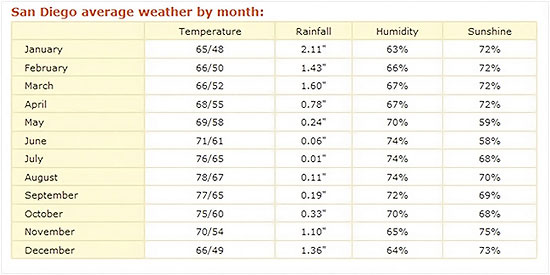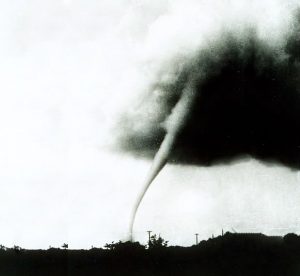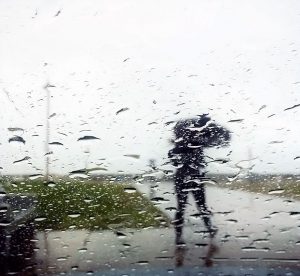San Diego Beaches Weather
 You can get a weather report almost anywhere these days. To supplement daily weather reports, we've decided to share our 30 years of experience with San Diego weather. Hopefully you'll get an idea of what type of weather to expect when traveling to San Diego.
You can get a weather report almost anywhere these days. To supplement daily weather reports, we've decided to share our 30 years of experience with San Diego weather. Hopefully you'll get an idea of what type of weather to expect when traveling to San Diego.
You may have heard that San Diego has the best weather in the U.S., if not the world. That is absolutely true much of the year. But what if you travel here and the weather is overcast or wet? We'll fill you in on what to expect each season.
 December through March
December through March
Let's start with December through March when the average monthly rainfall is 1.4 to 1.9 inches with 5 to 7 wet days per month. Wet days are usually grouped together. The average daily high temperature is 66 degrees (F) and low is 50 degrees (F).
What we've seen over the years is that storms tend to come through about once a week during these months. There are definite exceptions, especially during El Nino years when it can be wet and stormy for a week or more at a time. The wet weather can be intense, with wind and cool rain. However, rain usually doesn't last long — 12 to 24 hours at the most. And the weather before and after the rainy periods can be remarkably pleasant.
If you're planning on spending a week or more in San Diego during these months, plan for some rainy days. Remember, during some rainy periods, you can still enjoy the outdoors — just dress appropriately. We suggest packing a light- to medium-weight jacket or parka that is water and wind resistant (no insulation). Light- to medium-weight sweaters and fleece are good layers beneath your jacket. Many people wear long pants during these months. However, bring your shorts and T-shirts; some days are just right for the lighter clothing.
These are typical weather patterns from December to March, but there are some extremes that may surprise you. Most years will see a stretch of 1 to 2 weeks of near-perfect weather during this period, usually associated with Santa Ana conditions (high pressure over Utah or the Four Corners area). Daytime highs of 75 to 80 degrees are not uncommon. The beach is very inviting but the water is still cold — 60 degrees (F) or less. Near the end of March, warm weather is more common.
Now for the cold. We've experienced a daytime high of 45 degrees (F) in downtown San Diego with a wind chill of less than 32 degrees (F)! However, this is uncommon. Frost is also uncommon downtown or at the beaches but not inland.
If the jet stream locks in a southerly pattern, San Diego can see extended periods of wet, cool, windy weather. This happens during most years at least once and lasts 1or 2, weeks straight, hopefully not during your vacation! If it does happen, remember, there are breaks between storms when the weather is very pleasant. Time your activities accordingly. San Diego has never recorded measurable snowfall but flurries have been reported inland and hail is common.
In summary, expect mild, pleasant weather, but don't be surprised to see rain or cool weather. Most of all, be prepared for it.
 April through June
April through June
Average combined rainfall for April, May, and June is only 1.1 inches with most occuring the first week or two of April. Average daily highs are 70 degrees (F); lows, 55 degrees (F). March and April are windy, but not uncomfortably so; they're great months to fly kites at Mission Bay or the beaches. Consider yourself fortunate if you see any rainfall during this period, especially May and June.
April weather is some of San Diego's best.! Daytime highs of 70 to 75 degrees are not uncommon, with a near-perfect relative humidity of 60 percent and bright blue skies. The end of April ushers in the beginning of the night-and-morning-low-clouds-and-fog period, which peaks mid to late May and lasts through June. Locals refer to this as the "June gloom," when the coast can stay overcast and foggy for weeks. Many beachgoers have been surprised and disappointed during these months. Often, the clouds and fog will clear up several miles inland but not at the beach. However, most days the beaches receive some sun, usually in the afternoon
If you're staying at the beach during this period, don't be surprised to see fog and low clouds. Even though the temperatures are mild, it can still feel chilly. We recommend a light, wind-resistant jacket and/or mid- to heavy-weight sweatshirts. Shorts are fine most days with a sweatshirt. Travelers might consider planning inland activities during the morning and heading to the beach for the afternoon.
The only extreme weather worth noting during these months is extended periods of fog or sunshine. We've seen 2- to 3-week stretches of no sunshine and 2- to 3-week stretches with no fog or clouds. It's best to expect something in between.
 July through October
July through October
Now for the best weather of the year: July through October. Average daily high temperatures range from 73 to 78 degrees (F), with low temperatures of 60 to 65 degrees (F). Rainfall is almost nonexistent. There's not much else to say but "enjoy". The sun is out, the water is warm, and the beach is the place to be.
Temperatures in September and October can be unusually warm — sometimes as high as the 90s — but this is rare. You still might see fog or clouds in the morning but expect early burn-off.
 November
November
That leaves us with November, a transition month between summer and winter. Some years, you might see all warm sunny days; others, you may see significant rainfall. We suggest planning on a combination of the two.
Best San Diego Weather Links
NODC's Ocean Water Temperature Chart
Tide Predictions
San Diego National Weather Service
By John Rogers, Senior Editor of Enlightened Explorer Travel
Hurricane in San Diego
The 1858 San Diego hurricane ( pdf) was a very rare California hurricane. It is the only known tropical cyclone to impact California and originated in the eastern Pacific making landfall Oct. 2 with 85 mph sustained winds. In San Diego there was heavy rain and great property damage with many homes losing their roofs. Trees were uprooted and fences were destroyed. Three schooners, the Plutus, the Lovely Flora, and the X.L. were blown ashore.

Weather over Southern California.
Ad Space
San Diego Tornado
On April 6, 1926, an F2 tornado (113 to 157 mph winds) was recorded in San Diego County that injured 8 people.

San Diego County Tornado of 1926 - not actual photo of the event
San Diego Rainfall Records
The wettest year was 1941 with 24.93 inches (63.3 cm) and the driest year was 1953 with 3.23 inches (8.2 cm). The most rainfall in one month was 9.09 inches (23.1 cm) in January 1993. The most rainfall in 24 hours was 3.23 inches (8.2 cm) on April 5, 1926.

Rainy day at Mission Beach, San Diego, 2016.

